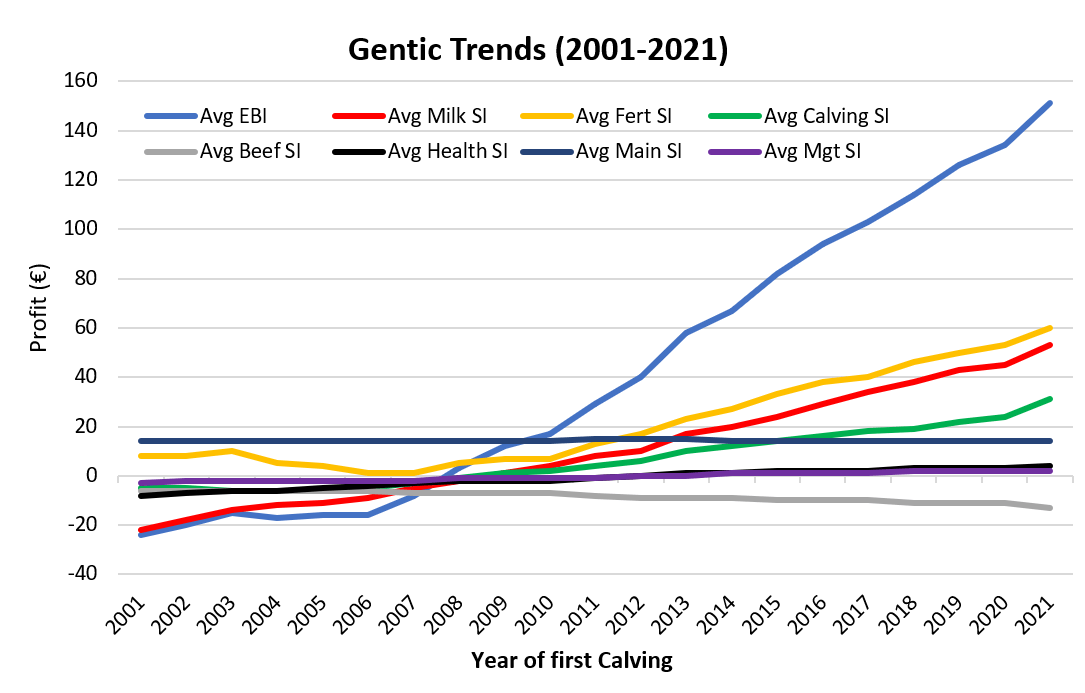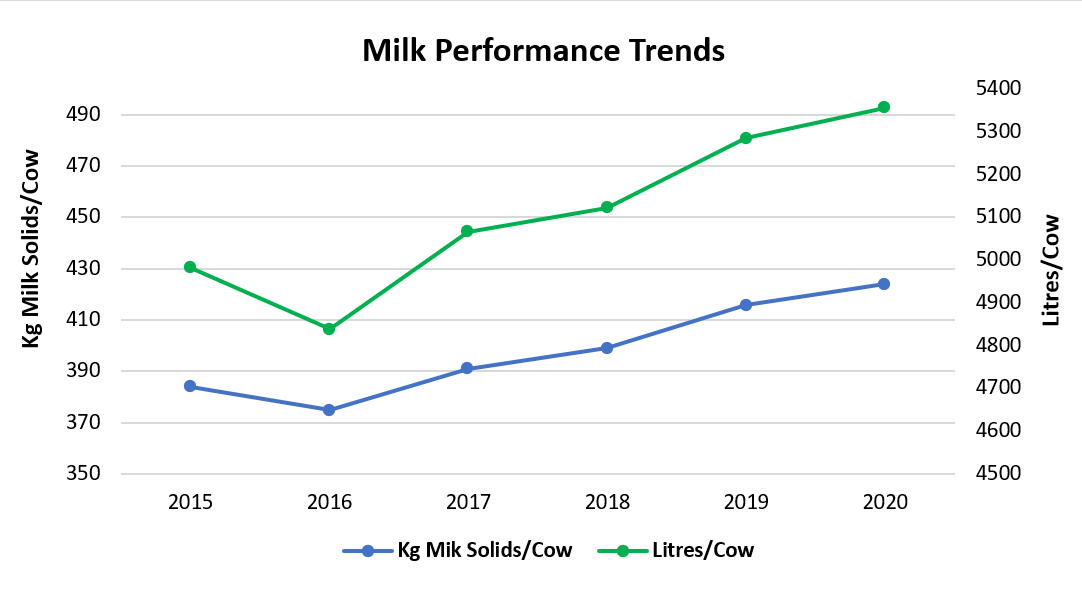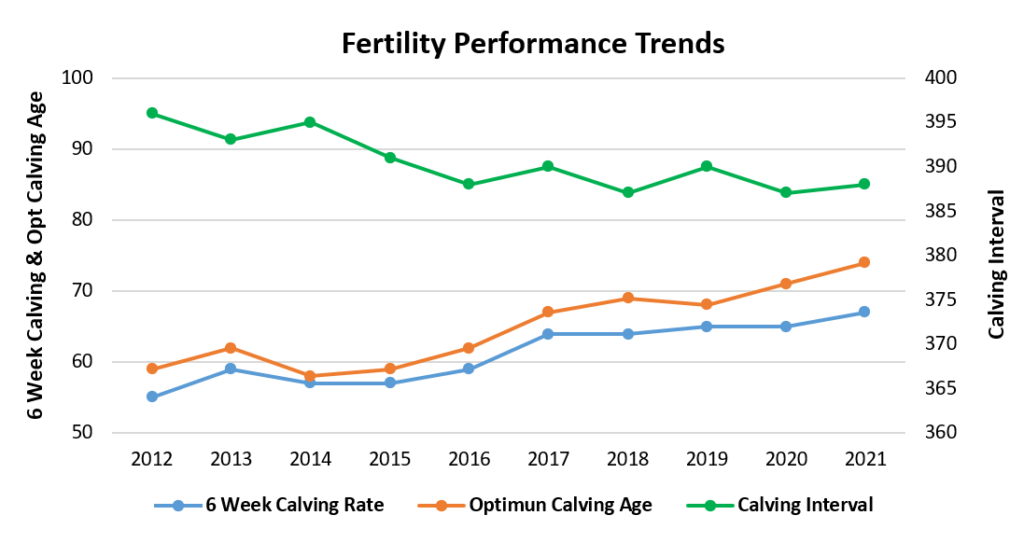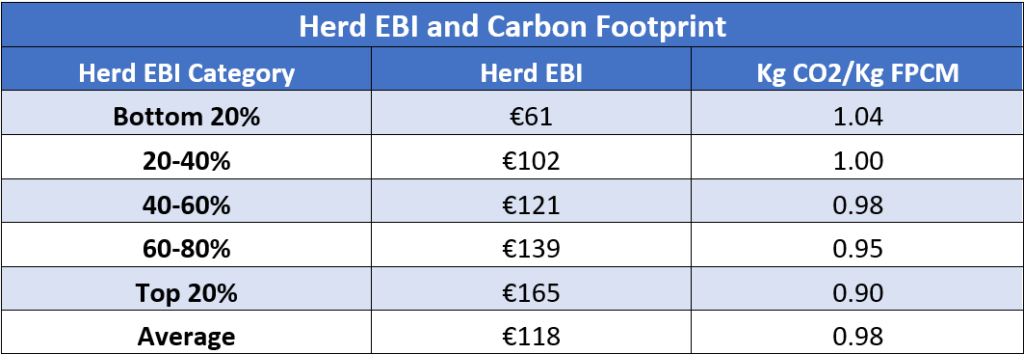The rate of genetic gain in EBI has accelerated rapidly over the last number of years, propelled mainly by two important initiatives, the launch of the Dairy Gene Ireland breeding programme in 2005 and the introduction of genomic selection in 2009. The current annual trend in the EBI is now at €11.4/year, based on 1ST parity females over the last 5 years. The nationwide increase in genetic gain has obvious benefits, most notably the increased profit per lactation. The expected EBI of 1ST parity females in 2030 is expected to be €254, based on the current rate of genetic gain.
The average EBI and the sub-indexes of heifers entering the Irish dairy herd is presented in graph 1 below. The graph illustrates the rate of genetic gain that has been achieved nationally over the last 20 years. The average EBI of first calving heifers in 2021 is €175 greater than first calving heifers 20 years ago. This equates to an extra €350 per lactation for heifers calved this year, compared to the heifers of 2001. This equates to an additional 5.3 cent per litre for farmers.

While the fertility sub-index of the national herd has made great progress, the fertility performance is still behind the industry targets. A fertility sub-index of approximately €100 with good management is required to achieve these targets. Therefore, considerable emphasis still needs to be placed on fertility within the EBI. Selecting high EBI sires with high fertility sub-indexes will improve on farm fertility and increase the genetic merit of your herd. As cows are starting to live longer, animal health is becoming even more important. Selecting sires with better genetic merit for health traits will also improve the health status of your herd.
National Milk and Fertility Performance Trends
Relating these genetic gain trends to actual milk performance of the national dairy herd shows that milk solids per cows has increased significantly, from 384 Kg/Ms per lactation for cows calving in 2015, to 424 Kg/Ms for cows calving in 2020. The milk performance trends (graph 2) shows the improvements that have been made in both litres and milk solids produced per cows over this period.

Similar improvements are also clear for the female fertility performance in the national dairy herd. This is highlighted in Graph 3 below. The average calving interval has been declining progressively, from 396 days for cows calving in 2012, to 388 days for cows calving this year. The six-week calving rate has also improved, going from 55% to 67% over this period. The national average for heifers calving down between 22-26 months of age has also improved from 59% to 74% in the same period. While the overall fertility performance trends are very positive, further improvements can still be made to achieve our reproductive targets.

Environmental Impact of EBI
Selection on EBI is also contributing to the lower carbon footprint of dairy herds through a combination of improvements in milk solids yield, better reproductive performance, and greater longevity. Recent analysis involving ICBF, Bord Bia and Teagasc on the carbon emission produced on dairy farms, has demonstrated that higher EBI herds produce less GHG emissions compared to the lower EBI herds. Herds in the top 20% for herd EBI produced 0.14 Kg lower carbon emission than herds in the bottom 20%. This can be seen in table 1 below. Therefore, genetic gain through improving EBI is a key contributor to the abatement of carbon on Irish dairy herds.

Gene Ireland and Genomic Selection
Gene Irelands bulls (G1 bulls) are the latest and highest EBI bulls that are available for the first year. The use of these young genomic sires will speed up the rate of genetic gain in your herd. Analysis of 6,190 herds (See table 2) shows herds that used a high percentage of G1 and GS bulls achieved the best genetic gain. For herds that used greater than 20% of G1 sires, the average EBI of their heifers was €31 higher compared to heifers born in herds that didn’t use any G1 sires. Again this equates to €62 per lactation of lost gains!

Genotyping Replacements
Genotyping dairy replacements has many benefits for farmers. It provides a more accurate prediction of the true value of an animal’s genetics along with parentage verification of individual animals. Accurate parentage is vital both for genetic gain and to avoid inbreeding. The DNA based registration programme, which is genotyping at birth, will have major benefits for the industry. The aim is to genotype the entire national herd by 2030 which will further increase the accuracy of genetic evaluations and help to achieve a reduction in GHG emissions nationally.
Summary
The latest genetic trends, clearly confirm EBI is selecting for a more profitable and environmentally efficient cow for Irish farmers. The national breeding programme and genomic selection have both contributed greatly to the increased rate of gain genetic gain in the national herd. The application of HerdPlus reports, decision support tools and genomic technology will help you make more informed management decisions on-farm.
